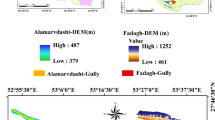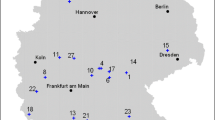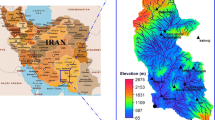Abstract
The topographic threshold for overland flow gully head represents a promising tool for both research development and users. Nevertheless, some of the basic assumptions that were used to derive the threshold equation are also at the base for errors, including systematic ones, which introduce bias in the evaluations. Particularly, the assumption that the gully head catchment (GHC) area is a synonym for runoff causes is often false. This cause errors when calculating the threshold equation parameters (i.e. exponent and coefficient of the power equation linking critical slope gradient near the gully head to the GHC area). The assumption implies that every part of the GHC is connected via continuous overland flow paths to the outlet at the moment of peak discharge. Larger areas require larger concentration times, hence longer rainfall duration. This makes the occurrence of a rainfall intensity of the right duration to allow the total connectivity of the GHC less frequent (i.e. less probable). Also the land use (characterized by a specific vegetation type) and the soil conditions could have an effect on the probability that the previous assumption is verified. In order to show this, a distributed model developed in R was used to analyse where the conditions for gully erosion are actually verified. The hydrological part was developed based on the curve number (CN) approach, including the simulation of peak discharge with a few modifications/adaptations to a spatially distributed environment. A small routine was added to simulate concentrated flow erosion and condition for gully head formation. Then, a set of simulations were run using a series of daily rainfall amount and different land use/soil scenarios. Results show a clear effect of the vegetation distribution and patterns on gully head position in the simulated landscapes. From these results, it becomes evident that CN-weighted average in composite catchments needs to be replaced by a different averaging procedures, where the fraction of catchment area as CN weight is completed by an additional weight based on distances to the catchment outlets of the different land uses.









Similar content being viewed by others
References
De Baets S, Torri D, Poesen J, Salvador MP, Meersmans J (2008) Modelling increased soil cohesion due to roots with EUROSEM. Earth Surf Process Landf 33(13):1948–1963
Elsebaie I (2012) Developing rainfall intensity–duration–frequency relationship for two regions in Saudi Arabia. J King Saud Univ Eng Sci 24:131–140
Frankl A, Poesen J, Deckers J, Haile Mitiku, Nyssen J (2012) Gully head retreat rates in the semi-arid Highlands of Northern Ethiopia. Geomorphology 173–174:185–195
Hawkins RH, Ward TJ, Woodward DE, Van Mullem JA (2009) Curve number hydrology—state of practice. ASCE publication, ISBN 978-0-7844-1004-2
Minh-Nhat L, Tachikawa Y, Kaoru Takara K (2006) Establishment of intensity–duration–frequency curves for precipitation in the monsoon area of Vietnam. Annu Disaster Prev Res Inst Kyoto Univ 49B:93–103
Montgomery DR, Dietrich WE (1994) Landscape dissection and drainage area–slope thresholds—Chapter 11. In: Kirkby MJ (ed) Process models and theoretical geomorphology. Wiley, New York, pp 221–246
Morel-Seytoux HJ, and Verdin JP (1983) Correspondence between the SCN CN and infiltration parameters (Ks and Sf). In: Proceeding of the ASCE specialty conference of the irrigation and drainage division, advances in irrigation and drainage: surviving external pressures, Jackson, Wyoming, pp 308–319
Nachtergaele J, Poesen J, Sidorchuk A, Torri D (2002) Prediction of concentrated flow width in ephemeral gully channels. Hydrol Process 16(10):1935–1953
Neteler M, Mitasova H (2004) Open source GIS: a GRASS GIS approach. Springer, New York
NRCS USDA (2012) National engineering handbook hydrology chapters—NEH Part 630, http://www.nrcs.usda.gov/wps/portal/nrcs/detailfull/national/wntsc/?cid=stelprdb1043063 (last visited 2014 Sept., 30)
Patton PC, Schumm SA (1975) Gully erosion, Northwestern Colorado: a threshold phenomenon. Geology 3:88–90
Poesen JWA, Torri D, and Vanwalleghem T (2011) Gully erosion: procedures to adopt when modelling soil erosion in landscapes affected by gullying. In: Morgan RPC & Nearing MA (eds) Handboook of erosion modelling, chap 19. ISBN: 978-1-4051-9010-7, Hardcover, 416 pages. Wiley-Blackwell, pp. 360–386
Prosser IP, Abernethy B (1996) Predicting the topographic limits to a gully network using a digital terrain model and process thresholds. Water Resour Res 32:2289–2298
R Development Core Team (2014) R: a language and environment for statistical computing. R Foundation for Statistical Computing, Vienna, Austria. ISBN 3-900051-07-0. http://www.R-project.org
Rodzik J, Furtak T, Zglobicki W (2009) The impact of snowmelt and heavy rainfall runoff on erosion rates in a gully system, Lublin Upland, Poland. Earth Surf Process Landf 34(14):1938–1950. doi:10.1002/esp.1882
Rossi M (2014) Modeling of landslide phenomena and erosion processes triggered by meteo-climatic factors. Ph.D. Thesis. Advisor: Fausto Guzzetti, Dino Torri, Daniela Valigi. Università degli Studi di Perugia, Italia. doi:10.13140/2.1.3835.0404
Rossi M, Torri D, Diele F, Marangi C, Ragni S, Blonda P, Nagendra H, Marchesini I, Santi E (2013) Deliverable No: D6.5 “Report on habitat state and ecosystem status assessment, 28 Jan 2013
Rossi M, Torri D, Santi E, Bacaro G, Marchesini I, Mondini AC and Felicioni G (2015) Slope dynamics and climatic change through indirect interaction. In: Lollino G et al (eds) Engineering geology for society and territory—vol 1, 551. Springer International Publishing Switzerland. doi:10.1007/978-3-319-09300-0_103
Salvador Sanchis MP, Torri D, Borselli L, Bryan R, Poesen J, Yañez MS, Cremer C (2009) Rill and gully junctions: estimating the parameters of the width-discharge relation in the field. Earth Surf Process Landf 34:2023–2030
Torri D, Borselli L (2003) Equation for high-rate gully erosion. Catena 50:449–467
Torri D, Poesen J (2014) A review of topographic threshold conditions for gully head development in different environments. Earth Sci Rev 130:73–85
Torri D, Poesen J, Borselli L, Knapen A (2006) Channel width—flow discharge relationships for rills and gullies. Geomorphology 76:273–279
Torri D, Santi E, Marignani M, Rossi M, Borselli L, Maccherini S (2013) The recurring cycles of biancana badlands: erosion, vegetation and human impact. Catena 106:22–30
Willgoose G, Bras RL, Rodriguez-Iturbe I (1991) A physical explanation of an observed link area–slope relationship. Water Resour Res 27(7):1697–1702
Author information
Authors and Affiliations
Corresponding author
Rights and permissions
About this article
Cite this article
Rossi, M., Torri, D. & Santi, E. Bias in topographic thresholds for gully heads. Nat Hazards 79 (Suppl 1), 51–69 (2015). https://doi.org/10.1007/s11069-015-1701-2
Received:
Accepted:
Published:
Issue Date:
DOI: https://doi.org/10.1007/s11069-015-1701-2




